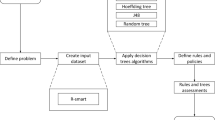Abstract
Deflection yoke (DY) is one of the main components of the color display tube (CDT) that determines the image quality of a computer monitor. Once a DY anomaly is found during production, the remedy process is performed in two steps: identifying the type of anomaly from the observed problem pattern and adjusting manufacturing process parameters to rectify it. To support this process, we introduce a knowledge-based system using a hybrid knowledge acquisition technique and case-based reasoning. The initial phase of the knowledge acquisition employs a systematic and quantitative data processing including stepwise regression and an inductive learning algorithm. This automated expertise elicitation produces strategies, which are represented by decision trees or if-then rules, to specify DY anomalies from display patterns. The strategies are then refined by introducing human expertise. The knowledge acquisition process was designed to support for this cognitive cooperation. For coordinating the process parameters to remedy the specified anomalies, a case-based reasoning is utilized. The laboratory and field test proved that the developed knowledge-based system could produce highly effective decisions for the process control in DY production.
Similar content being viewed by others
Explore related subjects
Discover the latest articles, news and stories from top researchers in related subjects.References
D.D. Woods, “Cognitive technologies: The design of joint human-machine cognitive systems,” AI Magazine, vol. 16, no. 4, pp. 86-92, 1986.
A. Hart, “Role of induction in knowledge elicitation,” in Knowledge Acquisition for Expert Systems: A Practical Handbook, edited by A.L. Kidd, Plenum Press: New York, 1987.
H. Liu and R. Setiono, “Incremental feature selection,” Applied Intelligence, vol. 9, pp. 217-230, 1998.
H. Almuallim and T.G. Dietterich, “Learning Boolean concepts in the presence of many irrelevant features,” Artificial Intelligence, vol. 69, nos. 1-2, pp. 279-305, 1994.
M. Park, I. Lee, and K. Shon, “Using case-based reasoning for problem solving in a complex production process,” Expert Systems With Applications, vol. 15, pp. 69-75, 1998.
B.M. Chung, C.K. Hong, C.O. Jung, and C.H. Park, “Intelligent adjustment for magnetic field of deflection yoke,” FUZZ-IEEE '95, pp. 1555-1560, 1995.
J.R. Quinlan, “Induction of decision trees,” Machine Learning, vol. 1, pp. 81-106, 1986.
B. Evans and D. Fisher, “Overcoming process delays with decision tree induction,” IEEE Expert-Intelligent Systems & Their Applications, vol. 9, pp. 60-66, 1994.
L. Talavera and U. Cortes, “Exploiting inductive bias shift in knowledge acquisition from ill-structured domains,” in Proc. 10th European Workshop EKAW '97, Springer Verlag, pp. 377-382, 1997.
D.C. Montgomery and E.A. Peck, Introduction to Linear Regression Analysis, John Wiley & Sons, Inc., 1992.
S. Piramuthu, N. Raman, and M.J. Shaw, “Integration of simulation modeling and inductive learning in an adaptive decision support system,” Decision Support Systems, vol. 9, pp. 127-142, 1993.
J.R. Quinlan, C4.5: Programs for Machine Learning, Morgan Kaufmann Pub.: San Mateo, CA, 1993.
J. Durkin, Expert Systems: Design and Development, Prentice Hall, Inc.: Englewood Cliffs, 1994.
A. Ginsberg, S.M. Weiss, and P. Politakis, “Automatic knowledge base refinement for classification systems,” Artificial Intelligence, vol. 35, pp. 197-226, 1988.
D.B. Leake, Case-Based Reasoning: Experiences, Lessons, and Future Directions, MIT Press: Cambridge, MA, 1996.
J.L. Kolodner, “Improving human decision making through case-based decision aiding,” AI Magazine, vol. 12, no. 2, pp. 52-68, 1991.
Author information
Authors and Affiliations
Rights and permissions
About this article
Cite this article
Park, MK., Lee, K.K., Shon, KM. et al. Automating the Diagnosis and Rectification of Deflection Yoke Production Using Hybrid Knowledge Acquisition and Case-Based Reasoning. Applied Intelligence 15, 25–40 (2001). https://doi.org/10.1023/A:1011210407578
Issue Date:
DOI: https://doi.org/10.1023/A:1011210407578




